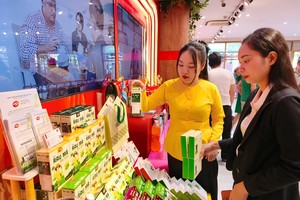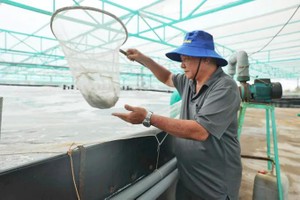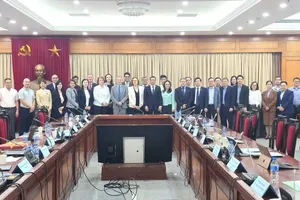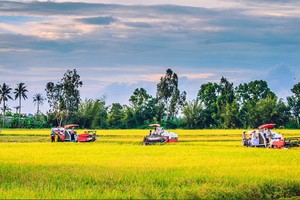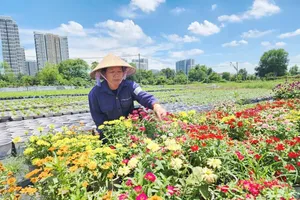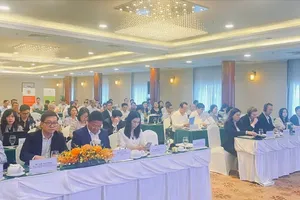 |
Rice harvesting in a large-scale field (Photo: SGGP) |
Director Nguyen Nhu Cuong of the Crop Production Department under the Ministry of Agriculture and Rural Development explained the two primary reasons for the surface area shrinkage of large-scale fields nationwide. Firstly, the economic potential of business partners is not strong enough to support farmers in the aspects of seed and fertilizer provision as well as technique guidance. In addition, the link between the former and the latter is rather loose, mostly not based on legally valid contracts but spoken agreements.
Discussing the ways that such agricultural enterprises like Loc Troi, Trung An have been able to nurture the growth of large-scale rice fields in the Mekong Delta until now, Director Cuong commented that they have successfully addressed the above issues. Not only do they own sufficient capital to support farmers, but they have also signed specific contracts with rice growers, foreign rice buyers for stable high prices. Some even create cooperatives to strengthen this link with farmers.
Stressing that capital lack is one key factor for the shrinkage of large-scale fields in Vietnam, the Director voiced that it is necessary to introduce a strong supporting policy by the State. For instance, it could introduce a credit support package with a lower interest rate than the one in the market and more flexibility (lending money through alliance contracts between businesses and cooperatives). Enterprises can use this loan to invest in plant growing (buying seeds, fertilizer, pesticide, herbicide) to distribute to farmers; then buy rice at the harvesting time.
Alternatively, the State can launch a short-term credit package for farmers to invest in their own plant growing process as long as these people are referred by a cooperative and have a contract with a business for output guarantee.
Evaluating the role of agricultural cooperative lately, Director Cuong said that this organization is extremely effective to address the three major obstacles of the Vietnamese agriculture: small-scale, fragmented, and spontaneous. Participating in a cooperative, farmers must follow a specific crop growing procedure under a formal plan.
Nevertheless, for a cooperative to thrive, its leaders must have administration capability and sufficient experience, along with strong capital. Farmers and enterprises must consider a cooperative as a legal entity, and thus the contract between an enterprise and a cooperative as a business one. It is completely different from spoken agreements between farmers themselves and enterprises, with no legal responsibilities at all, which might be harmful to either partner when the other break this agreement.
As to the direction of the Agriculture and Rural Development Ministry to encourage large-scale fields in the country, Director Cuong shared that this Ministry is preparing the project ‘1 million hectares of high-quality rice field and green growth in the Mekong Delta’.
To be submitted to the Government this year, the project is based on the large-scale field model, with clear criteria on field linking, business partners, identification of the requirements of businesses and farmers in this partnership. From those ideas, the Agriculture and Rural Development Ministry proposes that the State should introduce policies and support packages to both farmers and businesses.
Minister of Agriculture and Rural Development Le Minh Hoan insisted that for the large-scale field model to maintain and expand nationwide, there must be different approach methods according to the specific features of each region in order to transform the mind of the public to the agricultural economy.
Not only a combination of various small fields, but this model is also a way to increase the produce quality as well as quantity. Therefore, a value chain must be formed alongside the expansion of the surface area of large-scale fields. The role of cooperative economy, especially agricultural cooperatives as a legal representative, is key to link between individual farmers and businesses.
Deputy Director Tran Thai Nghiem of the Can Tho City Department of Agriculture and Rural Development said that in the large-scale field model, seeds are simultaneously sowed, then crops are harvested all at the same time. This might prove challenging for businesses, which often need a huge amount of money to purchase produce then.
In Can Tho City, on average, an enterprise must have VND120 billion (US$5.1 million) to purchase rice in each harvesting period, not to mention the wage to hire laborers, goods transport means, rice milling. Therefore, Vietnam State Bank should work with commercial banks to support businesses in that peak time (short-term loan from 3 – 5 months).
Chairman of the Directors Board of Loc Troi Co. Huynh Van Thon shared that the role of a cooperative in the large-scale field model is extremely important. Sadly, not many regions have well-operative cooperatives to closely link farmers and enterprises. It is essential that the local authorities help farmers by establishing such necessary organizations.
Farmer Thai Van Can from Hong Ngu District of Dong Thap Province voiced that localities must work with research institutes to create new rice types that are suitable for the land features of each region to achieve the highest possible yield.
Meanwhile, farmers must be regularly updated with advanced growing techniques to improve their performance. The functional agencies must collaborate with related units to provide precise forecast on the market demands so that farmers and businesses are more active in their crop growing activities.




